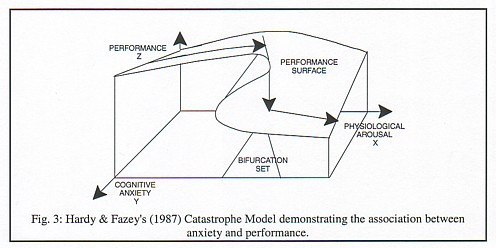Catastrophe Model

Hardy and Frazey (1987)
Sports psychologists have noted that performance does not always gradually decrease as arousal increases, as shown in the inverted ‘U’ theory. Instead many top sports people ‘go to pieces’ in the big event.
Catastrophe theory shows a much more dramatic decline in performance.
Physiological arousal is related to performance in an inverted ‘U’ fashion when the athlete is not worried or has low cognitive anxiety state anxiety.
If cognitive anxiety is high, the increases in arousal pass a point of optimal arousal and a rapid decline in performance occurs (the catastrophe). It would be very difficult to recover from this point.
The theory takes into account that anxiety (negative reaction of performer to stress) can be of two types:
Somatic anxiety – physiological, e.g. sweating
Cognitive anxiety – psychological, e.g. worry about failing. (NB – cognitive most crucial in determining performers reaction to high levels of stress).
The catastrophe theory concludes that increases in levels of cognitive anxiety will help performance if somatic anxiety is low. So if the body is relaxed but the performer is feeling anxious then this anxiety can help to improve performance.
If there is an increase in cognitive anxiety & somatic anxiety is high then performance will decline.
If there are high levels of cognitive anxiety & there is a continuous increase in somatic anxiety/physiological arousal then performance can suddenly deteriorate – a ‘catastrophic’ response.
If after this catastrophic effect, arousal decreases, then performance will once again improve but not back to its originally optimum level.
